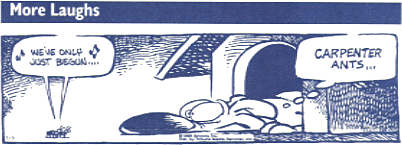How To Fix
Squeaky Floors |
Have you ever encountered
squeaky floors? Before your client installs new carpeting, attempt to fix the squeaks.
Most squeaking can be stopped by repairing the bare floor after the old carpet is removed.
Walk over the floor and mark squeaky areas with a piece of chalk. Try to find the source.
Loose floorboards are usually the culprit. When stepped on, they move slightly and rub
against each other or the nails that hold them. Re-nail or screw down any boards that
move. Use special flooring nails with ringed shanks or decking screws for a tighter grip.
Drive nails or screws into floor joists. joists are typically 16 inches apart and can
often be located by thumping on the floor in different places until you hear a
"solid" sound.
Squeaks might be temporarily stopped by lubricating the floor. Sweep talcum powder into
the cracks of noisy floor boards or apply a liquid wax to those areas.
| Note: This newsletter is for informational purposes only. When
getting involved with a project, please work within your ability. If you need help with a
contractor or with any other home-related issue, please contact Alban Home Inspection
Service with any questions. Thank You. |
|
|
Unplugged... |
Do you know why newer electrical plugs and
outlets have one prong that's
wider than the other? The plugs and outlets are polarized for protection against shock.
Making one prong on the plug wider ensures that it can be inserted into an outlet only one
way. |
 |
Here's how the one-way connection
improves safety: The hot wire in the electrical circuit. generally a black-insulated wire,
serves the small slot. A neutral wire, insulated white, serves the wide slot.
Inserting a polarized plug into a polarized outlet ensures that the hot wire feeds
electricity only through its switch. If the neutral side of a plug could be inserted into
the hot side of an outlet, electrical current would bypass the switch and deliver
electricity - in a lamp, to the base of the bulb, even with the switch off. That could
result in a shock if it were accidentally touched; for example, while changing a bulb. |
| Which Way Do Ceiling Fans Turn? |
Most ceiling fans can rotate in two
directions. But do you
know which is the proper direction for the warmer and cooler months?
In warmer months, the fan should rotate in a direction that gives a downward air flow. You
should be able to feel this flow by standing under the fan when it is running at a
moderate speed. |
 |
| When using a fan in cooler
months, reverse the rotation to pull air upward. If in doubt, cut a narrow strip of toilet
paper about six inches long and hold it under the fan while it is rotating. The paper
should be pulled toward the fan. The object of running a ceiling fan in cooler months is
to pull warm air toward the ceiling and recirculate in the room, theoretically making the
room more comfortable. The fan should run slowly so it does not create a draft, which will
have a cooling effect. |
 |
 |
| Full Fee Refund Offer if sale doesn't close! |
|| First Page
|| Back to Index Page || Alban
Home || |
|
|